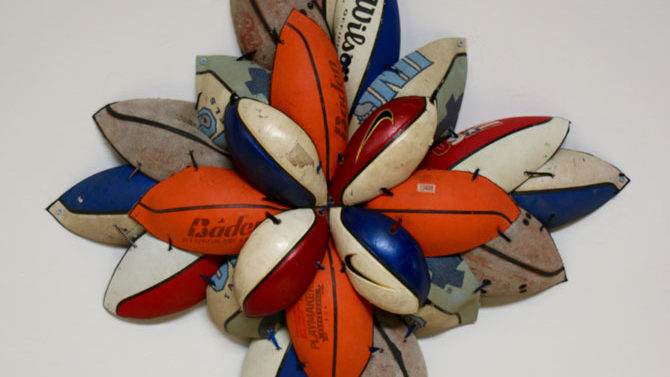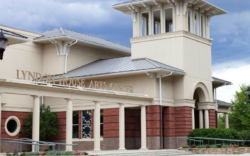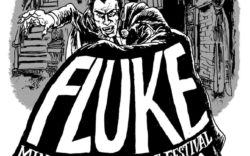smalltownBIGCITY: The term “vernacular” in Southern art is often a pejorative implication of a “low” culture, wherein locally available resources pose creative limitations on self-taught artists. Such a perception belittles the artist’s capacity for intentional, thoughtful expression and narrows the viewer’s reception of the artwork. Tennessee-based artists Kelly Porter and Brandon Donahue present a fresh, contemporary take on the creative Southern vernacular in “smalltownBIGCITY,” the Athens Institute for Contemporary Art’s first show since terminating the position of gallery director, formerly held by Tatiana Veneruso. Their concepts of the visual vernacular draw from familiar public imagery, from DIY mom-and-pop shop graphics to symbols of hip hop and graffiti, forming a dynamic conversation speaking to the rich diversity of Southern culture.
For both artists, their artwork is very personal and driven by personal life experiences. According to Porter, “Our work starts from the same roots: growing up and living in the South, our influences, memories and sense of place. But we built the show on the contrasts between our work.”
Porter and Donahue entered their master’s program together at the University of Tennessee in 2010. Three years later, their exit thesis show shared a gallery, and it was then that the artists noticed the multi-level interplay between their bodies of work. “My work is slower and more contemplative, and Brandon is faster and louder,” reflects Porter. “We love the back and forth nature of the work when it’s put together in a gallery setting.”
Contrast is apparent everywhere in “smalltownBIGCITY.” Porter’s work is cerebral, muted and balanced, whereas Donahue’s is energetic, bright and exaggerated. Both use repurposed and restructured objects in their sculptural work, a conscious reinterpretation of the unconscious framing imposed by local signs and symbols on our Southern life experience and collective memory.
Porter’s clean-lined sculptural designs speak to her background as a graphic designer. Casually propped on the floor against a wall in a deceptively ordered layout, a group of seven small-scale wooden panels collectively titled “Mixed Messages” make evident the influence of graphics on the artist. The panels are painted with numbers and letters, like cropped versions of storefront signs and small-town advertisements. Devoid of narrative, elements of the composition are highlighted: the color of peeling paint, the texture of cracked wood. They are objects whose time and place clearly belongs to the past, yet composed in a way that can only be a product of the present day.
Porter’s organic-based sculptures complement Donahue’s more industrial materials like rubber and metal, an echo of the contrast between the rural and urban. Donahue says, “In my work ‘vernacular’ means the everyday symbols and signs that we mentally digest. I think of basketballs and street signs as everyday, public, recreational and shared community experiences. Street signs are authoritative, yet so repetitious and widespread that the signs themselves are vernacular objects.”
Next to street signs emblazoned with present-day celebrity spray-paint portraits, Donahue’s “Basketball Blooms” stand out as abstract, meditative compositions. The series began in 2012 with a question of inner content and meaning: What is inside of this object, and what can its form reveal? The basketballs, collected from abandoned playgrounds around Tennessee, were cut open and reconstructed with shoestrings to create a flower-like mandala form.
Donahue recounts, “I wanted to pull from my athletic upbringing, by using an object that could be represented as a communal and recreational object.” The blooms speak to Donahue’s interest in object transformation—altering form, content and meaning in what he calls a process of material “alchemy.”
As a whole, “smalltownBIGCITY” represents the reception and transformation of cultural signs and symbols into sculptural works of art, continuing this creative process in the viewer’s mind. Along the same lines, the show represents the artists’ attempt to confront and reclaim the visual vernacular. It embodies a reevaluation of the Southern landscape and a renewal of the value of locality.
The show concludes its month long installation on Friday, Mar. 18 from 6–8 p.m. with a closing party, at which the artists will be present for celebration and discussion of their work.

Emily Armstrong and Pat Ivers
Scene and Screen: Art Rocks Athens and Georgia Humanities present “The Scene and the Screen: the Athens, GA/NYC Connection,” a celebration of punk music and its documentation in the 1980s. Led by visiting New York video artists Pat Ivers and Emily Armstrong, this two-day event features screenings of never-before-seen footage from punk’s legendary performers, as well as two discussion panels. The screenings will draw from Ivers’ and Armstrong’s video collection of punk performances, now digitized and part of the Fales Library’s Downtown Collection at NYU.
The event kicks off at Ciné on Friday, Mar. 18 at 7:30 p.m. Selections will be shown from Ivers’ and Armstrong’s GoNightclubbing video series, focusing on the history of New York punk music. Highlights from the series include Iggy Pop, Johnny Thunders, early performances by Bad Brains and the first New York appearances of Dead Kennedys. Next, an exclusive screening of a full music set from Athens’ own Pylon, taped at the Danceteria in NYC in 1980, will be shared. A panel discussion featuring the band’s surviving members, Michael Lachowski, Vanessa Briscoe Hay and Curtis Crowe, will follow the screening.
Saturday’s proceedings take place at UGA’s Special Collections Library beginning at 1:30 p.m. Ivers and Armstrong will show their “greatest hits” video collection—starring John Cale, Richard Hell and the Voidoids, The Cramps and more—followed by a panel discussion where Ivers and Armstrong will discuss the digitization of their video collection. The panel also includes Ruta Abolins, director of the Peabody Collection at the Special Collections Library, and local filmmaker Erica McCarthy, who will act as moderator. The afternoon concludes with selections from recorded interviews with such figures as Richard Lloyd from Television, Jeff Magnum and Cheetah Chrome from the Dead Boys and Jay Dee Daugherty and Lenny Kaye from the Patti Smith Group.
Like what you just read? Support Flagpole by making a donation today. Every dollar you give helps fund our ongoing mission to provide Athens with quality, independent journalism.










